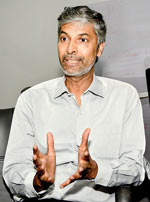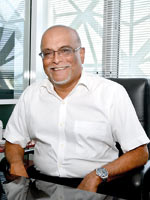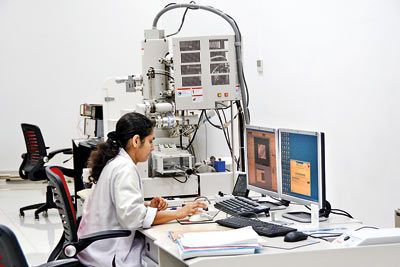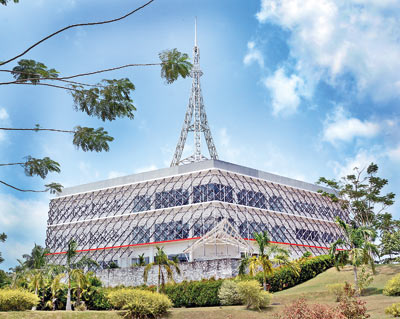‘Small is beautiful – the Nano revolution at Homagama’

Harin de Silva Wijeyeratne,
HOMAGAMA – Let’s cut to the chase immediately. This sheet of newspaper you are holding in your hand is about 100,000 nanometres thick. This is the minute, nay micron, scale on which 70 local scientists hidden in Homagama, a few km outside Colombo, are working on trying to engineer this country’s emergence as a tech-savvy nation. At the helm are a Cambridge University professor and a former investment banker, who with others are shaping a bright future at the Sri Lanka Institute of Nanotechnology (SLINTEC) – the country’s first hub for nanoscience where eureka moments are born.
Such moments can transform the lives of everyone from farmers toiling on the paddy fields of Polonnaruwa to nervous patients in hospital beds around the country.
The science might be beyond the normal sight of the human eye, but its vision can be breathtaking when the breakthrough happens. ”Our aim is to help Sri Lanka’s economy move up the food chain,” says Prof. Gehan Amaratunga, Chief of Research and Innovation at the nanoscience park. The former Royalist who left these shores 41 years ago has won accolades and been the toast of British engineering. He now spends his time between Cambridge University and his motherland as he dreams about turning the island nation’s economy from “cheap” to “smart”. Well-versed in technology start-ups having founded five companies with hundreds of millions of dollars in investment back in Britain, Prof. Amaratunga was tailor-made to head the research department at the country’s first nanotechnology centre soon after it was opened in October 2013.

Prof. Gehan Amaratunga
Sillicon Valley
It is not quite Silicon Valley in the salubrious Southern California Bay Area, and you have to keep an eye out for a narrow and winding village road forking off the A4 Highway just past downtown Homagama. It opens up at Pitipana on to a 50-acre site, where perched imperiously on a hill is a futuristic ‘green’ building which is the pride of Sunanda Gunasekera who is in charge of the technical services and infrastructure. Built at a cost of Rs. 800 million, the institute probably has the densest population of PHDs in the country – 21 – most of whom earned their doctorates abroad.
We are greeted by chief executive officer Harin de Silva Wijeyeratne, who in his previous life was an investment banker earning petro dollars in the Middle East but has now returned home to do something more ‘tangible” with his life.
Laidback and effusive, the CEO quickly maps out the fundamentals at SLINTEC. At its core, it is a public-private partnership between the Government of Sri Lanka and six private companies – MAS Holdings, Brandix, Dialog, Hayleys, Loadstar and Lankem.
Agri-based
The government’s outlay is close to Rs. 2 billion. Apart from the Rs. 800 million which went into the bricks and mortar for the main building and other facilities, another Rs.600 million went to equip the centre with space age technology while another equal share was for equity. This last Rs.600 million was matched in total by the half-a-dozen private partners. “It is a state-of-the-art facility where we are working with material one-billionth the size of a metre in a bid to make Sri Lanka competitive on a global scale,” outlines Mr. Wijeyeratne.
Traditionally this country’s economy has been agricultural-based. So it makes sense when Mr. Wijeyeratne ticks off agriculture as one of the key areas of focus for research and development. With two leading garment companies in the mix, apparel is another area while a lot of time is also spent on looking into water purification, healthcare and mineral resources. Although the institute is funded by six private partners, research is for the greater good of Sri Lanka’s industry as a whole. Unless there is a specific target and goals in which case the private party will have to ante up more rupees to realise its dreams.
First established in 2006, the institute is only now coming into its own since moving into its new home in Homagama a few years ago. Already results are forthcoming and one patent has been filed – for agriculture – with a number more on the verge of fruition. ”Sri Lanka has always been a trading nation more than a manufacturing nation but to be competitive globally, we have to change that,” explains Mr. Wijeyeratne. “To go to the next level so that we can compete on a global level we have to spend money of research and innovation.” As a nation, the country is dragging its feet and is way back in the race to develop new ideas and new products. In 2013, Sri Lanka spent only 0.11 per cent of its GDP on research and development – and this is on the whole caboodle not just nanotechnology.
In contrast even tiny Nepal spent three times what Sri Lanka did on R&D (in 2010) while our giant neighbour India spent 0.9 per cent of its GDP on trying to get a technological edge. Of course all these figures pale into comparison when the West is taken into the equation. The United States spends more than 2.8 per cent of its GDP and Germany 2.9 per cent. Japan is the big spender on R&D dishing out 3.4 per cent of its GDP in 2014 – no wonder a Japanese car is much-sought after.
Yet, in our small way, we have made a start. And we can’t be but impressed as we are shown around the Institute which Mr. Gunasekera says is the “greenest building in the world”.

A lab technician at work
Clean-as-a-whistle-water
You can drink out of the toilet with rainwater being harnessed for flushing; solar produces 100 KW of power and the natural flow of convection air cools the giant atrium where fish swim in algae green water. But it is the heart of the building which impresses us. Situated 16 feet below ground it houses the most expensive instrument in the country – a giant transmission electron microscope which can scan images one-50,000th size of a human hair. At a cost of Rs.250 million it is the only such microscope in the country, ideal for the world of nanotechnology where an inch is measured as 25,400,000 nanometres – or put in another way, if a marble were a nanometre, then one metre would be the size of the earth.
Perhaps this is why we have to remove our shoes before entering its hallowed presence – well apart from helping to keep its confinement sterile. The microscope along with another scanning electron microscope, which at Rs.80 million is loose change compared to its more venerable elder, and an atomic force microscope are housed below ground so as to minimise external vibrations which can impact on such sensitive machines. Even while we are there, one female scientist has detected a minute vibration which has upset the readings on her machine and she is in a tizzy.
We don’t tell her that those vibrations are probably my stomach rumbling as it is way past lunchtime. You can spend hours lost in a dream world. There is a room where the air is so clean – the air that we breathe has a billion particles apparently – but this room has less than 5,000 particles. Michael Jackson and Bubbles would have loved it. At ground level Prof. Amaratunga brings us back to reality when he reveals the fruits of Homagama are already ripe with promise.
A nano-fertiliser has been developed and is being trialed and if proven successful it can help transform agriculture in this country significantly. “We have developed a nano-urea fertiliser which if successful after tests will allow farmers to use less fertiliser but get a bigger yield of paddy. While the costs won’t go down significantly, environmentally it will be better as less fertiliser is used.”

The complex. Pix by M. D. Nissanka
Nano-fertiliser
The rights have been sold to an Indian company with Hayleys being the local partner. If and when this nano-fertiliser comes on to the market, it is estimated that it will reduce the use of fertiliser in paddy cultivation by nearly 25 per cent. Prof. Amaratunga believes it will help the government recover its two billion-rupee investment on the Homagama institute in one year. Mind-boggling, but that’s the huge scope of the dreams. His is just one facet. In medicine, nanotechnology can be used as a delivery system whereby specific cells, say cancer, are targeted leaving the surrounding tissue toxic-free.
Or in this world where water is fast-becoming a scarce commodity – the United Nations estimates that more than one billion people in developing economies do not have sufficient access to clean water – nanoscience can provide filters that remove chemicals and carcinogens from water with unprecedented efficiency. Three years ago, the institute began an endowment scheme whereby well-wishers and philanthropists could get involved by donating money for research and development. To-date Rs.32 million has been donated with one large chunk, Rs. 25 million, coming from Ricky Mendis, one-time chairman of the Delmege Forsyth Group.
The financial contribution and the human touch – with our best minds returning to work at home – give much hope for the future. Prof. Amaratunga encapsulates it best: “I won’t be here if I was not excited at the potential of this Institute. This is part of the national development ethos.” While the brain drain is reversed in Homagama, plans are also afoot to start a Technology Incubation Centre where people with nascent ideas can come to check the effectiveness of their products.
“Before taking the step of spending on commercialising the product, we will test it and provide all ancillary support like legal, marketing, raising funds, basically mentoring and guiding them. What we are doing here is not only trying to win the World Cup for Science, but to also deliver the next Lasith Malinga of science,” Mr. Wijeyeratne added. Now that would be something if nanotechnology helped Sri Lanka cricket scatter the stumps of the world’s opposition.


